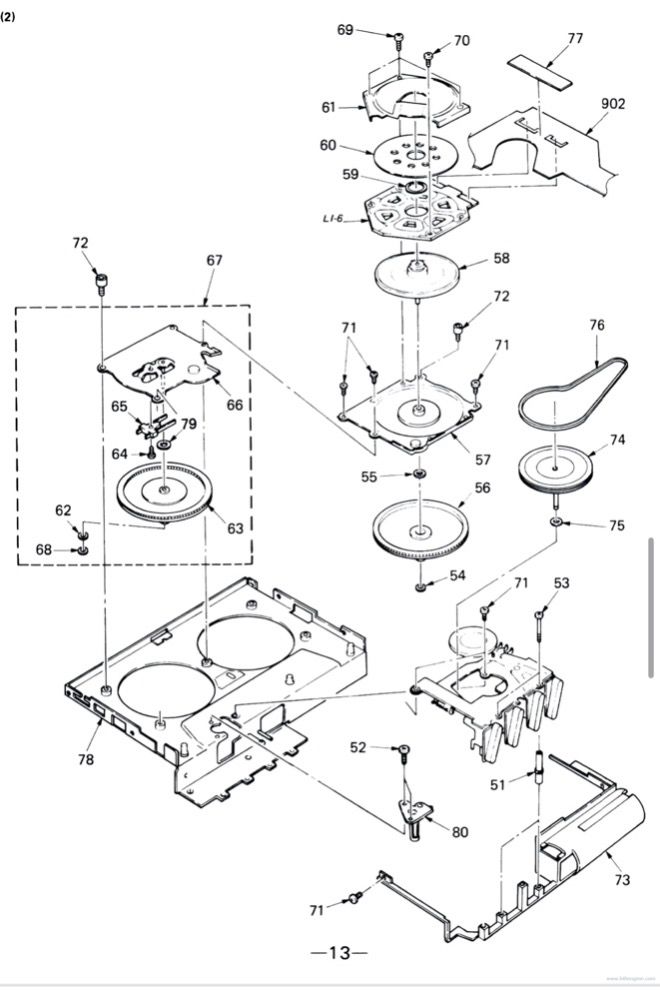
When I met Heather a few years back, I asked her what she was into and she said “Electronic Music.” I asked her if she was into anything else, and she said “no.”
Heather Mease is a composer whose works concerns the intersections of early and later music, media-specificity, and the history and practice of electronic music. Shitty Music on Tape and I Loved You a Lot is the 2024 tape from Semibegun, a multi-faceted project that includes the artist, a label, pamphlets and a radio series. This tape follows Semibegun 1 (2021), Stockhausen Serves the Worms (2023), and NO ONE NOTHING EVER (2023).
At the thematic core of this record,
it is an exploration of our emotional connection to the mechanical, the unreliable sonic nostalgia of mediums, and our pension to deposit our emotions into technology that is fading faster than ourselves. At times, this album sounds like your tape player is acting up, but the gremlin inside is Semibegun.
Rather than the ghost in the shell, this record is about the heart in the tape shell. The inner workings of the machine are a beating heart. The composition explores the liminal crossings of human and machine. Some of the emotional themes here concern joy, efficacy, what is necessary, qualities of relatedness, and being okay. It is the little mechanical taps that build your trust with who’s behind the machine.
On trust, Mease’s states that the themes of Shitty Music on Tape “are explicitly about fidelity in myriad ways––in terms of relationship communication, infidelity, and the fidelity of media. It’s about the copy and the original, the limits of
intelligibility, masking through noise, negative space and artifact becoming foreground. It is also about being trapped in cycles. We hear this in the use of imitation and canon (in terms of polyphony — connection to early music), delay, phasing, tape loops.”
Shitty Music on Tape and I Loved You a Lot pulls from a vast swath of sources. It uses the full frequency of the tape and a range of samples and instruments. This is the type of refined production you can always expect from a Semibegun release. I enjoyed this most with headphones, as the panning is really cool. Mease says the marked use of panning is related to the themes of cycles, in that it is about “composing out (the) cycles.” If anything, this tape is valuable for its lessons in production, how to use the full range, which tape are better than people give them credit for (do note that the music is described as shitty, tapes themselves are not shitty).

The album’s trademark elements are distant voice(s), live and sampled voices, some sung others spoken, sounds of the past and present, all of which tend to recede back towards the past. Chipped sounds, clipping and tape echo, blocks of gentle feedback, blocks of warped medieval music. Evoking a floating feeling, floating away, away, away, away, echoing throughout. This distance is an intentional affect, Mease states that the “distance is a result of the mediation- (the microphone being) a device itself, not just for voices.”
The track titles themselves echo these themes. What reads like classical terminology (possibly with jokes going over my head): “Antiphony”, “ripieno I” & “ripieno II” (riparoni?), is combined with emotional, casual titles “This Time, The Last Time,” “But Have You Tried.”
Starting with “Shame State.” There is an extended spoken word bit sampled across several tracks. A psychoanalysis lecture
on shame and guilt. whose themes are trust and isolation. The dislocated nature of the voice results in an uncanny relationship between these taped therapy sessions and Mease’s own confessional voice. Mease’s voice is separately established early on and the counseling session sample seems to come from the collective conscious.
These blips of human voice are intermittent, creating a web of the artist’s voice, the listening ear among the archives, we are pulled by the ear through the archive, an archive that consists of the Semibegun world and institutional archives.
There is a marked influence of the influential youtube video “1 hour of silence occasionally interrupted by Pikmin,” (currently at 3 million views).

Shitty Music on Tape and I Loved You a Lot is music for creative brainstorming. It is stimulating but you can never quite ignore
it, or get completely comfortable. Even when Shitty Music on Tape is comforting, it flits out to something entirely different, a quality that speaks to the compositional work here.
There are familiar tape artifacts, whipping sounds, “wee-EEP,” “WER-ip,” etc. An ever-shifting comment on our nostalgic connection to tape and various recording techniques.
Altogether, the lyrical features carve out a space for honesty, for the cited “shame state,” I see this quality most marked in the stretch of three tracks: “Shame State” “Feeling Touched (in a way)” and “Atlantic city on Christmas.”
The tape hiss never quite leaves, and never ever bothers the listener. Lovely tape hiss, tape hissssssssssssssssssssssss

Further to the composition, the structure breaks down in the second half.
I swore I heard a harpsichord in the second half, this reviewer doesn’t like harpsichord. On a re-listen, I
was mistaken, there is no harpsichord. The instrumentation of this record is so varied that it is bound to illicit different reactions as to our preconceived notions towards different instruments, mediums, and vocal styles.
The must-listen track is “Shitty Music on Tape.” The track is a bit buried being near the end of the record, but it carries the title for very good reason. If you only have time for one track, please make it this one.

(at low recording levels) (−20 dB referred to nominal level) all quality tapes can reliably reproduce frequencies from 30 Hz to 16 kHz, which is sufficient for high fidelity audio.
The original specification for Compact Cassette was set by Philips in 1962–1963. Of the three then available tape formulations that matched Philips requirements, the BASF PES-18 tape became the original reference. Other chemical companies followed with tapes of varying quality, often incompatible with the BASF reference. By 1970, a new, improved generation of tapes firmly established themselves on the market and became the de facto reference for aligning tape recorders — thus the compatibility issue worsened even further. In 1971 it was tackled by the Deutsches Institut für Normung (DIN), which set the standard for chromium dioxide tapes. In 1978 the International Electrotechnical Commission (IEC) enacted the comprehensive
standard on cassette tapes (IEC 60094). One year later the IEC mandated the use of notches for automatic tape type recognition. Since then, the four cassette tape types were known as IEC I, IEC II, IEC III and IEC IV. The numerals follow the historical sequence in which these tape types were commercialized, and do not imply their relative quality or intended purpose.

From the end user viewpoint, the IEC 60094 defined two principal properties of each tape type:
Bias level for each type was set equal to the optimal bias of the relevant IEC reference tape, and sometimes changed when the IEC changed the reference tapes, though the BASF datasheet for the Y348M tape, approved as the IEC Type I reference in 1994, says that its optimal bias is exactly 0.0 dB from the previous reference (BASF R723DG). The IEC reference tape bias definition is: Using the relevant IEC reference tape and heads according to
Ref. 1.1, the bias current providing the minimum third harmonic distortion ratio for a 1 kHz signal recorded at the reference level is the reference bias setting. Type II bias (‘high bias’) equals around 150% of Type I bias, Type IV bias (‘metal bias’) equals around 250% of Type I bias.[25] Real cassette tapes invariably deviate from the references and require fine tuning of bias; recording a tape with improper bias increases distortion and alters frequency response.

Compact Cassettes contain two miniature spools, between which the magnetically coated, polyester-type plastic film (magnetic tape) is passed and wound—essentially miniaturizing reel-to-reel audio tape and enclosing it, with its reels, in a small case (cartridge)—hence “cassette”. These spools and their attendant parts are held inside a protective plastic shell which is 4 by 2.5 by 0.5 inches (10.2 cm × 6.35 cm × 1.27 cm) at its largest
dimensions. The tape itself is commonly referred to as “eighth-inch” tape, supposedly 1⁄8 inch (0.125 in; 3.17 mm) wide, but actually slightly larger, at 0.15 inches (3.81 mm). Two stereo pairs of tracks (four total) or two monaural audio tracks are available on the tape; one stereo pair or one monophonic track is played or recorded when the tape is moving in one direction and the second (pair) when moving in the other direction. This reversal is achieved either by manually flipping the cassette when the tape comes to an end, or by the reversal of tape movement, known as “auto-reverse”, when the mechanism detects that the tape has ended.

Magnetic tape is not an ideal medium for long-term archival storage, as it begins to degrade after 10 — 20 years, with some experts estimating its lifespan to be no more than 30 years.

A common
mechanical problem occurs when a defective player or resistance in the tape path causes insufficient tension on the take-up spool. This would cause the magnetic tape to be fed out through the bottom of the cassette and become tangled in the mechanism of the player. In these cases, the player was said to have “eaten” or “chewed” the tape, often destroying the playability of the cassette. [failed verification] Splicing blocks, analogous to those used for open-reel 1/4” tape, were available and could be used to remove the damaged portion or repair the break in the tape.
Twitter: @PersonalRecords
IG: @manynestedtree